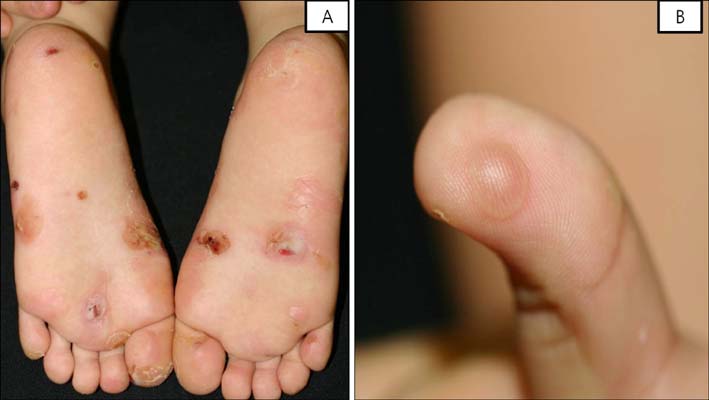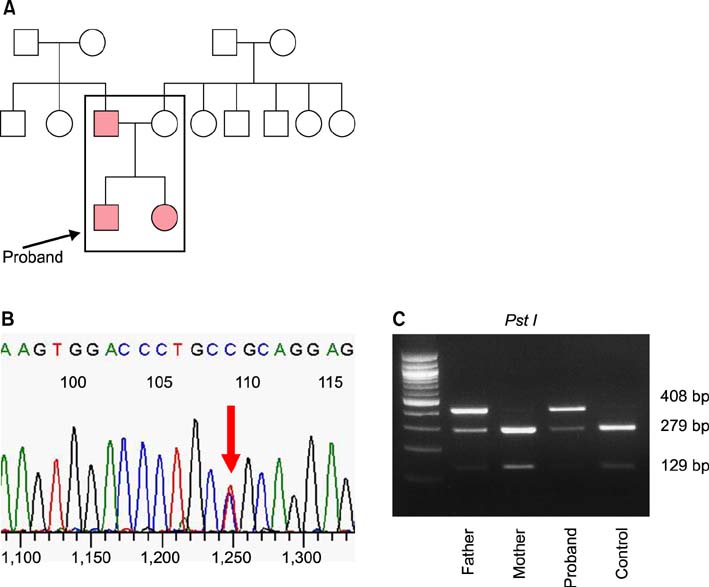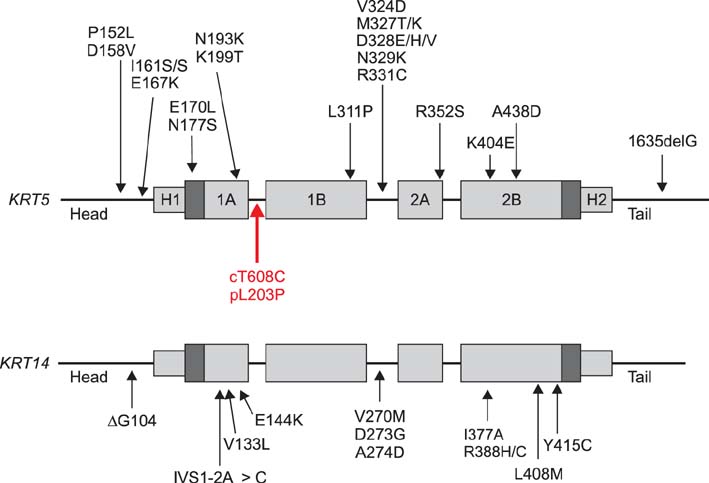Ann Dermatol.
2014 Dec;26(6):739-742. 10.5021/ad.2014.26.6.739.
Weber-Cockayne Type Epidermolysis Bullosa Simplex Resulting from a Novel Mutation (c. 608T>C) in the Keratin 5 Gene
- Affiliations
-
- 1Department of Dermatology, Keimyung University School of Medicine, Daegu, Korea. kmderma@dsmc.or.kr
- 2Department of Dermatology, Hirosaki University School of Medicine, Hirosaki, Japan.
- KMID: 2264870
- DOI: http://doi.org/10.5021/ad.2014.26.6.739
Abstract
- Epidermolysis bullosa simplex (EBS), an inherited genetic disorder, is most often caused by a dominant-negative mutation in either the keratin 5 (KRT5) or the keratin 14 (KRT14) gene. These keratin mutants result in a weakened cytoskeleton and cause extensive cytolysis. It is important to analyze the KRT5 or KRT14 genes of the patient and their family members by mutational analysis in order to identify genetic defects as well as the need for genetic counseling. In this study, we present a 5-year-old Korean boy who had been developing blisters and erosions on the palms of his hands and soles of his feet since infancy. In addition, while his younger sister and father showed similar clinical manifestation, his mother did not. The patient was diagnosed with EBS based on clinical manifestation, which is characterized by the presence of blisters restricted to the palms and soles, histological findings, and mutational analysis. Mutational analysis of the patient's DNA revealed a thymine-to-cytosine transition at codon 608 in the KRT-5 gene, resulting in a leucine-to-proline substitution in the keratin 5 protein. The same mutation was identified in the paternal, but not maternal, DNA. Here, we report a case of Weber-Cockayne type EBS with vesicles and bullae restricted to the palms and soles with a novel, paternally inherited mutation in KRT5 gene (exon2, c.608T>C).
MeSH Terms
Figure
Reference
-
1. Wolff K, Goldsmith LA, Katz SI, Gichrest BA, Paller AS, Leffel DJ. Fitzpatrick's dermatology in general medicine. 7th ed. New York: McGrawHill;2008. p. 505–516.2. Fine JD, Eady RA, Bauer EA, Briggaman RA, Bruckner-Tuderman L, Christiano A, et al. Revised classification system for inherited epidermolysis bullosa: Report of the Second International Consensus Meeting on diagnosis and classification of epidermolysis bullosa. J Am Acad Dermatol. 2000; 42:1051–1066.3. Fuchs EV. The molecular biology of epidermolysis bullosa simplex. In : Fine JD, Bauer EA, McGuire J, Moshell A, editors. Epidermolysis bullosa: clinical, epidemiologic, and laboratory advances, and the findings of the National Epidermolysis Bullosa Registry. Baltimore: Johns Hopkins University Press;1999. p. 280–299.4. Schweizer J, Bowden PE, Coulombe PA, Langbein L, Lane EB, Magin TM, et al. New consensus nomenclature for mammalian keratins. J Cell Biol. 2006; 174:169–174.
Article5. Steinert PM, Marekov LN, Fraser RD, Parry DA. Keratin intermediate filament structure. Crosslinking studies yield quantitative information on molecular dimensions and mechanism of assembly. J Mol Biol. 1993; 230:436–452.6. Irvine AD, McLean WH. The molecular genetics of the genodermatoses: progress to date and future directions. Br J Dermatol. 2003; 148:1–13.
Article7. Yasukawa K, Sawamura D, Goto M, Nakamura H, Jung SY, Kim SC, et al. Epidermolysis bullosa simplex in Japanese and Korean patients: genetic studies in 19 cases. Br J Dermatol. 2006; 155:313–317.
Article8. Cummins RE, Klingberg S, Wesley J, Rogers M, Zhao Y, Murrell DF. Keratin 14 point mutations at codon 119 of helix 1A resulting in different epidermolysis bullosa simplex phenotypes. J Invest Dermatol. 2001; 117:1103–1107.
Article
- Full Text Links
- Actions
-
Cited
- CITED
-
- Close
- Share
- Similar articles
-
- A Case of Weber-Cockayne Epidermolysis Bullosa Simplex - Ultrastructural Findings
- A Case of Epidermolysis Bullosa Simplex (Dowling-Meara 1 Type) in Newborn
- A Case of Koebner Variant of Epidermolysis Bullosa Simplex
- A Case of Epidermolysis Bullosa (Weber-Cockayne Type)
- A Case of Epidermolysis Bullosa Simplex ( Dowling - Meara Type )





